“Global 5G Modems Market to reach a market value of USD 10.5 Billion by 2031 growing at a CAGR of 28.9%”
The Global 5G Modems Market size is expected to reach $10.5 billion by 2031, rising at a market growth of 28.9% CAGR during the forecast period.
Wearable devices, including smartwatches, fitness trackers, and augmented reality glasses, require low-power connectivity solutions to ensure extended battery life and optimal user experience. The introduction of 5G technology enables wearables to leverage high-speed, low-latency connectivity while minimizing power consumption, enhancing the functionality and utility of wearable devices. Thus, the wearables segment held 12% revenue share in the 5G modems market 2023.
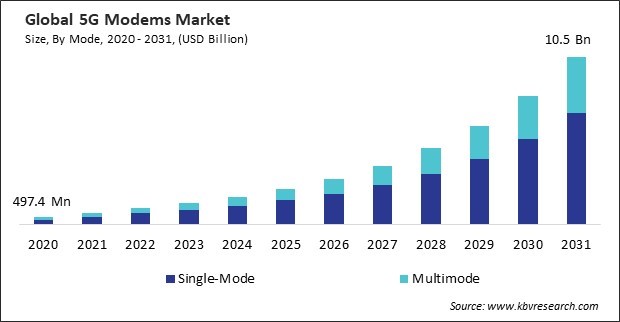
The major strategies followed by the market participants are Product Launches as the key developmental strategy to keep pace with the changing demands of end users. For instance, May, 2024, Qorvo launched a single-chip variable inverse cable equalizer for DOCSIS 4.0, enabling upgrades to cable networks for higher-speed broadband, including symmetrical multi-gigabit speeds. This innovation enhances network infrastructure, directly supporting 5G applications and improving connectivity options. Additionally, In March, 2024, Nokia has launched a symmetrical 25G PON fiber modem, offering speeds 20 times faster than current solutions. Its compact design supports seamless upgrades for telecom operators, enhancing high-speed broadband access for residential and business users across various applications, including AI and gaming.
Based on the Analysis presented in the KBV Cardinal matrix; Samsung Electronics Co., Ltd., Huawei Technologies Co., Ltd. and Qualcomm Incorporated are the forerunners in the 5G Modems Market. In March 2023, Samsung Electronics introduced its Exynos Modem 5300, a 5G telecommunications modem designed to compete with Qualcomm and MediaTek. Built with advanced 4-nanometer technology, it supports download speeds of up to 10 Gbps and targets Google's upcoming Pixel 8 smartphones. Companies such as MediaTek, Inc., Nokia Corporation and Infineon Technologies AG are some of the key innovators in 5G Modems Market.
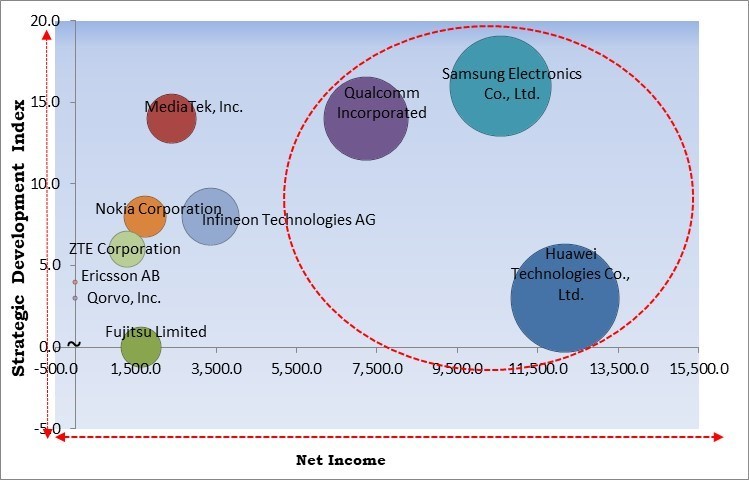
5G modems enable these devices to connect to 5G networks, unlocking faster data speeds and enhanced performance compared to previous generations of wireless technology. Therefore, the rising demand for high-speed connectivity drives the market's growth.
Additionally, Advanced encryption algorithms, authentication mechanisms, and secure boot protocols help protect user data and ensure the integrity and confidentiality of communications over 5G networks, enhancing trust and confidence in 5G-enabled services and applications. Hence, ongoing technological advancements are propelling the growth of the market.
Fabricating advanced semiconductor chips with nanometer-scale features and integrating complex radio frequency (RF) components require specialized manufacturing facilities, equipment, and expertise, adding to the overall cost of 5G modem production. Therefore, the high development cost and complex processes impede the market's growth.
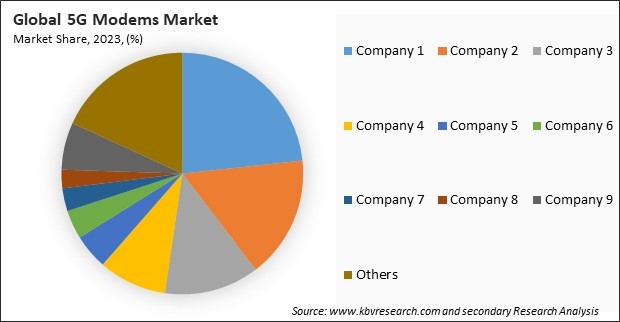
The leading players in the market are competing with diverse innovative offerings to remain competitive in the market. The above illustration shows the percentage of revenue shared by some of the leading companies in the market. The leading players of the market are adopting various strategies in order to cater demand coming from the different industries. The key developmental strategies in the market are Product Launches and Product Expansions.
Based on modem type, the market is bifurcated into internal/integrated and external. The external segment attained 14% revenue share in the market in 2023. External 5G modem modules offer modularity and flexibility to device manufacturers, allowing them to integrate 5G connectivity into a wide range of devices without significant redesign or engineering efforts.
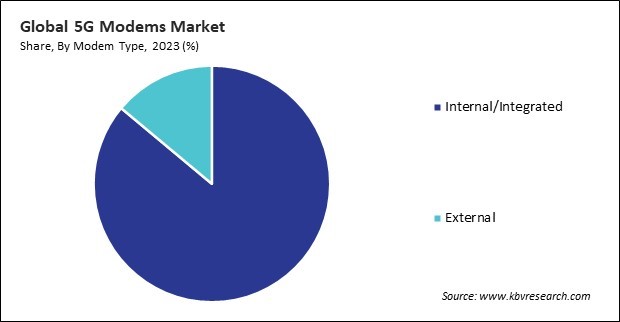
The internal/integrated segment is further subdivided into 10nm, 14nm, 20nm, 28nm, and others. In 2023, the 28nm segment held 11% revenue share in the market. 28nm 5G modems are well-suited for IoT applications, balancing performance, power efficiency, and cost-effectiveness.
Based on mode, the market is categorized into single-mode and multimode. The single-mode segment witnessed 68% revenue share in the market in 2023. Single-mode 5G modems are designed specifically for applications where 5G connectivity is the primary requirement, and backward compatibility with older wireless technologies like LTE or 3G is unnecessary.
By application, the market is divided into mobile and tablets, wearable, automotive, virtual reality, and others. In 2023, the mobile and tablets segment registered 43% revenue share in the 5G modems market. The advent of 5G technology addresses this demand by offering higher data speeds, lower latency, and enhanced network capacity compared to previous generations of wireless technology.
Free Valuable Insights: Global 5G Modems Market size to reach USD 10.5 Billion by 2031
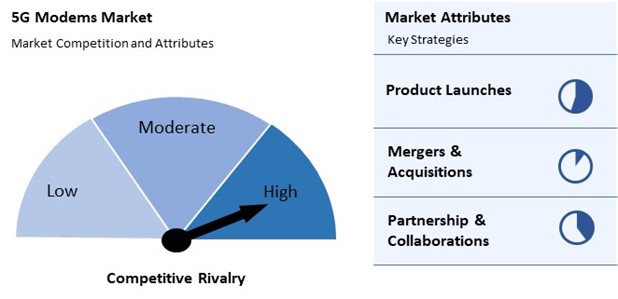
The 5G modems market is characterized by intense competition driven by technological advancements and increasing demand for high-speed connectivity. Key attributes influencing the market include modem performance, data transfer rates, and compatibility with various devices. Manufacturers are focusing on enhancing power efficiency and reducing latency to meet consumer expectations. Additionally, the integration of advanced features like beamforming and multi-band support is crucial for differentiation. As the market evolves, continuous innovation and strategic partnerships will be vital for capturing market share.
Region-wise, the market is analyzed across North America, Europe, Asia Pacific, and LAMEA. The LAMEA region generated 5% revenue share in the market in 2023. Rising demand for 5G modems in the LAMEA region is driven by growing mobile connectivity, emerging 5G infrastructure, enterprise adoption of Industry 4.0 initiatives, smart city projects, and rising consumer demand for advanced devices.
| Report Attribute | Details |
|---|---|
| Market size value in 2023 | USD 1.4 Billion |
| Market size forecast in 2031 | USD 10.5 Billion |
| Base Year | 2023 |
| Historical Period | 2020 to 2022 |
| Forecast Period | 2024 to 2031 |
| Revenue Growth Rate | CAGR of 28.9% from 2024 to 2031 |
| Number of Pages | 294 |
| Number of Tables | 463 |
| Report coverage | Market Trends, Revenue Estimation and Forecast, Segmentation Analysis, Regional and Country Breakdown, Competitive Landscape, Market Share Analysis, Market Share Analysis, Porter’s 5 Forces Analysis, Company Profiling, Companies Strategic Developments, SWOT Analysis, Winning Imperatives |
| Segments covered | Mode, Modem Type, Application, Region |
| Country scope |
|
| Companies Included | Qualcomm Incorporated (Qualcomm Technologies, Inc.), Samsung Electronics Co., Ltd. (Samsung Group), Huawei Technologies Co., Ltd. (Huawei Investment & Holding Co., Ltd.), MediaTek, Inc., Infineon Technologies AG, Nokia Corporation, Qorvo, Inc., Ericsson AB, Fujitsu Limited, and ZTE Corporation |
By Mode
By Modem Type
By Application
By Geography
This Market size is expected to reach $10.5 billion by 2031.
Rising demand for high-speed connectivity are driving the Market in coming years, however, Complex processes and high cost of development restraints the growth of the Market.
Qualcomm Incorporated (Qualcomm Technologies, Inc.), Samsung Electronics Co., Ltd. (Samsung Group), Huawei Technologies Co., Ltd. (Huawei Investment & Holding Co., Ltd.), MediaTek, Inc., Infineon Technologies AG, Nokia Corporation, Qorvo, Inc., Ericsson AB, Fujitsu Limited, and ZTE Corporation
The expected CAGR of this Market is 28.9% from 2024 to 2031.
The Internal/Integrated segment is leading the Market by Modem Type in 2023, thereby, achieving a market value of $8.7 billion by 2031.
The Asia Pacific region dominated the Market by Region in 2023, and would continue to be a dominant market till 2031; thereby, achieving a market value of $3.9 billion by 2031.
Our team of dedicated experts can provide you with attractive expansion opportunities for your business.

 Drivers
Drivers
 Restraints
Restraints
 Opportunities
Opportunities
 Challenges
Challenges
